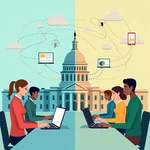The IELTS Reading test often explores complex topics, including the intersection of culture and technology in education. Today, we’ll examine a sample IELTS Reading test focused on “Cultural challenges in the integration of technology in remote learning.” This timely subject reflects the growing importance of how media education promotes cultural awareness in our increasingly digital world.
Passage 1 – Easy Text
The Rise of Remote Learning
The COVID-19 pandemic has accelerated the adoption of remote learning technologies worldwide, forcing educational institutions to rapidly adapt their teaching methods. This sudden shift has brought to light numerous challenges, particularly in terms of cultural differences and technological access. While some countries and communities have seamlessly transitioned to online platforms, others face significant hurdles.
In many developed nations, the integration of technology in education was already underway before the pandemic. Students in these countries often have access to high-speed internet and personal devices, making the transition to remote learning relatively smooth. However, the situation is markedly different in developing countries, where limited infrastructure and economic constraints pose significant barriers to effective online education.
Cultural attitudes towards technology and education also play a crucial role in the success of remote learning initiatives. Some societies place a high value on traditional face-to-face instruction and may be resistant to the idea of online education. This cultural skepticism can hinder the adoption of new teaching methods and technologies, even when they are readily available.
Questions 1-5
Do the following statements agree with the information given in the passage? Choose
TRUE if the statement agrees with the information
FALSE if the statement contradicts the information
NOT GIVEN if there is no information on this
- The COVID-19 pandemic has slowed down the adoption of remote learning technologies.
- Developed nations were better prepared for the transition to online learning.
- All developing countries lack the necessary infrastructure for effective remote learning.
- Cultural attitudes have no impact on the success of remote learning initiatives.
- Traditional face-to-face instruction is valued equally across all societies.
Questions 6-10
Complete the sentences below. Choose NO MORE THAN TWO WORDS from the passage for each answer.
- The pandemic has forced educational institutions to quickly __ their teaching methods.
- In developed nations, the integration of technology in education was __ before the pandemic.
- __ and economic constraints are significant barriers to effective online education in developing countries.
- Some societies may be __ to the idea of online education due to cultural attitudes.
- Cultural skepticism can __ the adoption of new teaching methods and technologies.
Passage 2 – Medium Text
Bridging the Digital Divide in Remote Learning
The rapid shift to remote learning has exposed and exacerbated the digital divide that exists both between and within countries. This divide is not merely about access to technology but also encompasses the skills and support needed to effectively utilize digital tools for learning. As educational institutions worldwide grapple with these challenges, it becomes evident that addressing the cultural aspects of technology integration is crucial for successful remote learning implementation.
In many rural and economically disadvantaged areas, the lack of reliable internet connectivity and access to devices poses a significant obstacle to remote learning. This technological gap often correlates with cultural and socioeconomic factors, creating a complex web of challenges. For instance, in some communities, shared family devices may be prioritized for work-related tasks rather than education, reflecting cultural values and economic necessities.
Moreover, the digital literacy levels among students, teachers, and parents vary widely across different cultural contexts. In societies where technology use is not widespread, there may be a steep learning curve for all parties involved in remote education. This disparity in digital skills can lead to frustration and disengagement, particularly among students who may feel left behind due to their lack of technological proficiency.
Cultural differences in teacher-student relationships also play a significant role in the effectiveness of remote learning. In cultures that prioritize hierarchical relationships and formal classroom settings, the transition to more informal, technology-mediated interactions can be challenging. Students accustomed to direct guidance and immediate feedback may struggle with the increased autonomy required in online learning environments.
 Digital divide in remote learning across cultures
Digital divide in remote learning across cultures
Language barriers present another layer of complexity in the integration of technology for remote learning. Many educational technologies and online resources are primarily available in English or a limited number of dominant languages. This linguistic dominance can marginalize students from non-English speaking backgrounds or minority language groups, potentially widening the achievement gap in remote learning settings.
To address these multifaceted challenges, educational institutions and policymakers must adopt culturally sensitive approaches to technology integration. This may involve developing localized content, providing multilingual support, and designing user interfaces that reflect diverse cultural norms and preferences. Additionally, how language education shapes cultural identity should be considered when implementing remote learning solutions to ensure inclusivity and effectiveness across different cultural contexts.
Questions 11-14
Choose the correct letter, A, B, C, or D.
-
The digital divide in remote learning refers to:
A) Only the lack of access to technology
B) The gap in internet speeds between countries
C) Differences in access to technology and skills to use it
D) The number of computers available in schools -
In rural and economically disadvantaged areas:
A) All families have dedicated devices for education
B) Internet connectivity is always reliable
C) Shared devices may be used for work instead of education
D) There are no cultural factors affecting technology use -
Digital literacy levels:
A) Are uniform across all cultural contexts
B) Only affect students’ ability to learn remotely
C) Vary widely among students, teachers, and parents
D) Are not important for remote learning success -
The effectiveness of remote learning can be impacted by:
A) Only the quality of internet connection
B) Cultural differences in teacher-student relationships
C) The type of device used for online classes
D) The time of day classes are held
Questions 15-19
Complete the summary below. Choose NO MORE THAN TWO WORDS from the passage for each answer.
The integration of technology in remote learning faces numerous cultural challenges. In some cultures, the transition to (15) __ interactions in online environments can be difficult for students used to formal classroom settings. Language barriers also present a challenge, as many educational technologies are available primarily in (16) __ or a few dominant languages, which can (17) __ students from non-English speaking backgrounds. To address these issues, a (18) __ approach to technology integration is necessary, which may include developing (19) __ content and providing support in multiple languages.
Passage 3 – Hard Text
Navigating Cultural Sensitivities in Global Remote Learning Platforms
The proliferation of global remote learning platforms has ushered in an era of unprecedented access to education across geographical boundaries. However, this democratization of knowledge comes with its own set of complex cultural challenges. As these platforms aim to cater to a diverse international audience, they must navigate a labyrinth of cultural sensitivities, pedagogical traditions, and societal norms that vary significantly across regions and communities.
One of the primary challenges lies in the cultural relevance of educational content. Materials developed in Western contexts may not resonate with learners from non-Western backgrounds, potentially leading to disengagement or misinterpretation. This issue extends beyond mere translation; it encompasses the need for culturally appropriate examples, case studies, and frameworks that reflect the lived experiences of diverse student populations. The concept of cultural imperialism in education becomes particularly salient in this context, as dominant cultural paradigms may inadvertently marginalize or invalidate alternative ways of knowing and learning.
Moreover, the pedagogical approaches embedded in many remote learning platforms often reflect Western educational philosophies, which may clash with traditional learning styles in other cultures. For instance, the emphasis on critical thinking, open debate, and questioning authority—cornerstones of Western education—can be problematic in societies that prioritize harmony, respect for elders, and collective wisdom. This cultural mismatch can create cognitive dissonance for learners and may even be perceived as a threat to cultural values and social cohesion.
 Cultural sensitivity in global remote learning platforms
Cultural sensitivity in global remote learning platforms
The issue of digital colonialism emerges as another critical concern in the global remote learning landscape. As large, predominantly Western tech companies dominate the e-learning market, there is a risk of perpetuating neo-colonial power structures through the control of educational content and data. This dominance can potentially stifle local educational initiatives and impose a homogenized view of knowledge, undermining cultural diversity in the digital learning ecosystem.
To address these multifaceted challenges, stakeholders in global remote learning must adopt a culturally responsive approach that goes beyond surface-level localization efforts. This approach requires a fundamental rethinking of content creation, platform design, and pedagogical strategies. How study abroad programs foster intercultural competence can provide valuable insights for developing culturally sensitive online learning environments.
Implementing adaptive learning systems that can tailor content and teaching methods to individual cultural contexts represents a promising avenue. These systems could leverage artificial intelligence to analyze learner behavior and preferences, adjusting the presentation of material to align with diverse cultural norms and learning styles. However, the development of such systems must be guided by ethical considerations to avoid perpetuating biases or reinforcing stereotypes.
Furthermore, fostering global collaboration in content creation and platform development is crucial. By involving educators, learners, and cultural experts from diverse backgrounds in the design process, remote learning platforms can better reflect the multiplicity of global perspectives. This collaborative approach not only enhances the cultural relevance of educational content but also promotes cross-cultural understanding and dialogue among learners.
The integration of indigenous knowledge systems into remote learning platforms presents another opportunity to enrich the global educational landscape. By acknowledging and incorporating diverse epistemologies, these platforms can challenge the hegemony of Western knowledge paradigms and create more inclusive learning environments. This inclusion can also serve to preserve and revitalize endangered knowledge systems, contributing to global cultural heritage.
As remote learning continues to evolve, the need for culturally sensitive approaches becomes increasingly urgent. The success of global educational initiatives will largely depend on their ability to navigate the complex interplay between technology, culture, and pedagogy. By embracing cultural diversity as a strength rather than a challenge, remote learning platforms can truly fulfill their potential to democratize education on a global scale.
Questions 20-23
Choose the correct letter, A, B, C, or D.
-
The main challenge in developing content for global remote learning platforms is:
A) Translating materials into different languages
B) Ensuring cultural relevance across diverse backgrounds
C) Creating visually appealing content
D) Reducing the cost of content production -
Western educational philosophies in remote learning platforms may be problematic because:
A) They are too advanced for non-Western learners
B) They require expensive technology
C) They may conflict with traditional learning styles in other cultures
D) They are not based on scientific research -
The concept of digital colonialism in e-learning refers to:
A) The exclusive use of colonial languages in online education
B) The dominance of Western tech companies in the e-learning market
C) The requirement for all students to study Western history
D) The use of outdated technology in developing countries -
Adaptive learning systems in culturally sensitive remote learning:
A) Are impossible to implement due to technological limitations
B) Could potentially reinforce cultural stereotypes if not carefully designed
C) Should only be used for teaching language courses
D) Are not necessary for addressing cultural differences
Questions 24-26
Complete the sentences below. Choose NO MORE THAN THREE WORDS from the passage for each answer.
- To create more inclusive learning environments, remote learning platforms should integrate __ into their content.
- The success of global educational initiatives depends on navigating the complex interplay between technology, culture, and __.
- By involving diverse stakeholders in the design process, remote learning platforms can better reflect __ of global perspectives.
Questions 27-30
Do the following statements agree with the claims of the writer in the passage? Choose
YES if the statement agrees with the claims of the writer
NO if the statement contradicts the claims of the writer
NOT GIVEN if it is impossible to say what the writer thinks about this
- Cultural imperialism in education is a minor issue that does not significantly affect remote learning.
- Adaptive learning systems can completely solve all cultural challenges in remote learning.
- Incorporating indigenous knowledge systems can challenge the dominance of Western knowledge paradigms.
- Global collaboration in content creation is unnecessary for developing culturally sensitive learning platforms.
Answer Key
Passage 1
- FALSE
- TRUE
- NOT GIVEN
- FALSE
- FALSE
- adapt
- already underway
- Limited infrastructure
- resistant
- hinder
Passage 2
- C
- C
- C
- B
- informal
- English
- marginalize
- culturally sensitive
- localized
Passage 3
- B
- C
- B
- B
- indigenous knowledge systems
- pedagogy
- the multiplicity
- NO
- NO
- YES
- NO
This comprehensive IELTS Reading practice test explores the intricate relationship between culture and technology in remote learning. As you prepare for your IELTS exam, remember that understanding diverse cultural perspectives is crucial not only for success in the test but also for effective communication in our interconnected world. The role of cultural festivals in school community building further illustrates how cultural awareness can enhance educational experiences.


